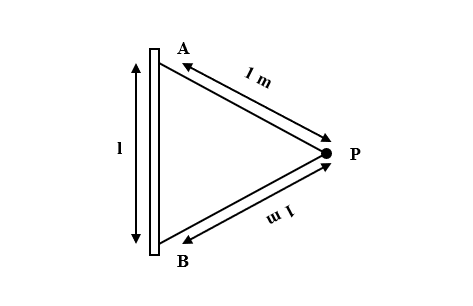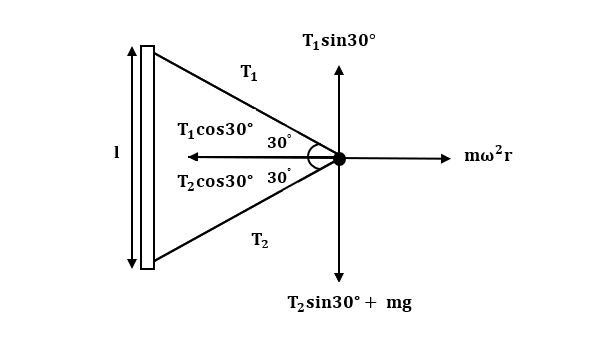
A particle P of mass m attached to a vertical axis by two strings AP and BP of length 1 m each. The separation AB= l. P rotates around the axis with an angular velocity $\omega$. The tension in the two strings are ${T}_{1}$ and ${T}_{2}$. Then,
(This question has multiple correct answers)

A. ${T}_{1}={T}_{2}$
B. ${T}_{1}+{T}_{2}=m {\omega}^{2} l $
C. ${T}_{1}-{T}_{2}= 2mg $
D. BP will remain taut only if $ \omega \geq \sqrt {\dfrac {2g}{l}}$

Answer
540.9k+ views
Hint: To solve this question first find the balancing forces in vertical direction. Then, find the balancing forces in horizontal direction. These balancing forces will be in terms of tension in the string. Then, subtracting these two equations. But the tension in the string along BP has to be greater than zero. So, substitute this condition and find the value for angular velocity.
Complete answer:

Let tension along AB and BP be ${T}_{1}$ and ${T}_{2}$ respectively.
All the sides of the triangle ABP are of the same length. Hence, it is an equilateral triangle and thus, all the angles are the same.
$\angle PAB= \angle ABP= \angle BPA= 60°$
Balancing the forces in vertical direction we get,
${T}_{1}\sin{30°}= {T}_{2}\sin{30°} + mg$
$\Rightarrow {T}_{1}\sin{30°}- {T}_{2}\sin{30°}= mg$
$\Rightarrow \sin{30°} ({T}_{1}-{T}_{2})= mg$
$\Rightarrow \dfrac {1}{2} ({T}_{1}-{T}_{2})= mg$
$\Rightarrow{T}_{1}-{T}_{2}= 2mg$ …(1)
Now, P rotates around the axis with an angular velocity $\omega$. Thus, the forces in horizontal direction is given by,
${T}_{1}\cos{30°}+{T}_{2}\cos{30°}= m{\omega}^{2}r$ …(2)
But, the radius of rotation is given by,
$r= l\cos{30°}$
Substituting above value in equation. (2) we get,
${T}_{1}\cos{30°}+ {T}_{2}\cos{30°}= m{\omega}^{2} l\cos{30°}$
$\Rightarrow \cos{30°} ({T}_{1}+{T}_{2})= m{\omega}^{2} l\cos{30°}$
$\Rightarrow {T}_{1}+{T}_{2}=m {\omega}^{2} l$ …(3)
Subtracting equation. (2) from equation. (3) we get,
${T}_{1}+{T}_{2}- {T}_{1}-{T}_{2}= m {\omega}^{2} l-2mg$
$\Rightarrow 2{T}_{2}= m {\omega}^{2} l-2mg$
To BP to remain taut, ${T}_{2}$ should be greater than zero.
$ m {\omega}^{2} l-2mg > 0$
$\Rightarrow m {\omega}^{2} l \geq 2mg$
$\Rightarrow {\omega}^{2} \geq \dfrac {2mg}{ml}$
$\Rightarrow {\omega}^{2} \geq \dfrac {2g}{l}$
$\Rightarrow \omega \geq \sqrt {\dfrac {2g}{l}}$
Hence, the correct answers are option B, C and D.
Note:
To solve these types of problems, students must analyze the figure and draw the free body diagram first. To draw an appropriate free body diagram, they should know the definition of it. Free body diagrams are diagrams used to show the relative magnitude and direction of all forces acting on the particle or an object in a given situation. It is also known as force diagram as it shows proper position and direction of forces.
Complete answer:

Let tension along AB and BP be ${T}_{1}$ and ${T}_{2}$ respectively.
All the sides of the triangle ABP are of the same length. Hence, it is an equilateral triangle and thus, all the angles are the same.
$\angle PAB= \angle ABP= \angle BPA= 60°$
Balancing the forces in vertical direction we get,
${T}_{1}\sin{30°}= {T}_{2}\sin{30°} + mg$
$\Rightarrow {T}_{1}\sin{30°}- {T}_{2}\sin{30°}= mg$
$\Rightarrow \sin{30°} ({T}_{1}-{T}_{2})= mg$
$\Rightarrow \dfrac {1}{2} ({T}_{1}-{T}_{2})= mg$
$\Rightarrow{T}_{1}-{T}_{2}= 2mg$ …(1)
Now, P rotates around the axis with an angular velocity $\omega$. Thus, the forces in horizontal direction is given by,
${T}_{1}\cos{30°}+{T}_{2}\cos{30°}= m{\omega}^{2}r$ …(2)
But, the radius of rotation is given by,
$r= l\cos{30°}$
Substituting above value in equation. (2) we get,
${T}_{1}\cos{30°}+ {T}_{2}\cos{30°}= m{\omega}^{2} l\cos{30°}$
$\Rightarrow \cos{30°} ({T}_{1}+{T}_{2})= m{\omega}^{2} l\cos{30°}$
$\Rightarrow {T}_{1}+{T}_{2}=m {\omega}^{2} l$ …(3)
Subtracting equation. (2) from equation. (3) we get,
${T}_{1}+{T}_{2}- {T}_{1}-{T}_{2}= m {\omega}^{2} l-2mg$
$\Rightarrow 2{T}_{2}= m {\omega}^{2} l-2mg$
To BP to remain taut, ${T}_{2}$ should be greater than zero.
$ m {\omega}^{2} l-2mg > 0$
$\Rightarrow m {\omega}^{2} l \geq 2mg$
$\Rightarrow {\omega}^{2} \geq \dfrac {2mg}{ml}$
$\Rightarrow {\omega}^{2} \geq \dfrac {2g}{l}$
$\Rightarrow \omega \geq \sqrt {\dfrac {2g}{l}}$
Hence, the correct answers are option B, C and D.
Note:
To solve these types of problems, students must analyze the figure and draw the free body diagram first. To draw an appropriate free body diagram, they should know the definition of it. Free body diagrams are diagrams used to show the relative magnitude and direction of all forces acting on the particle or an object in a given situation. It is also known as force diagram as it shows proper position and direction of forces.
Recently Updated Pages
Master Class 11 Economics: Engaging Questions & Answers for Success

Master Class 11 English: Engaging Questions & Answers for Success

Master Class 11 Social Science: Engaging Questions & Answers for Success

Master Class 11 Biology: Engaging Questions & Answers for Success

Class 11 Question and Answer - Your Ultimate Solutions Guide

Master Class 11 Business Studies: Engaging Questions & Answers for Success

Trending doubts
What is meant by exothermic and endothermic reactions class 11 chemistry CBSE

10 examples of friction in our daily life

One Metric ton is equal to kg A 10000 B 1000 C 100 class 11 physics CBSE

Difference Between Prokaryotic Cells and Eukaryotic Cells

What are Quantum numbers Explain the quantum number class 11 chemistry CBSE

1 Quintal is equal to a 110 kg b 10 kg c 100kg d 1000 class 11 physics CBSE




